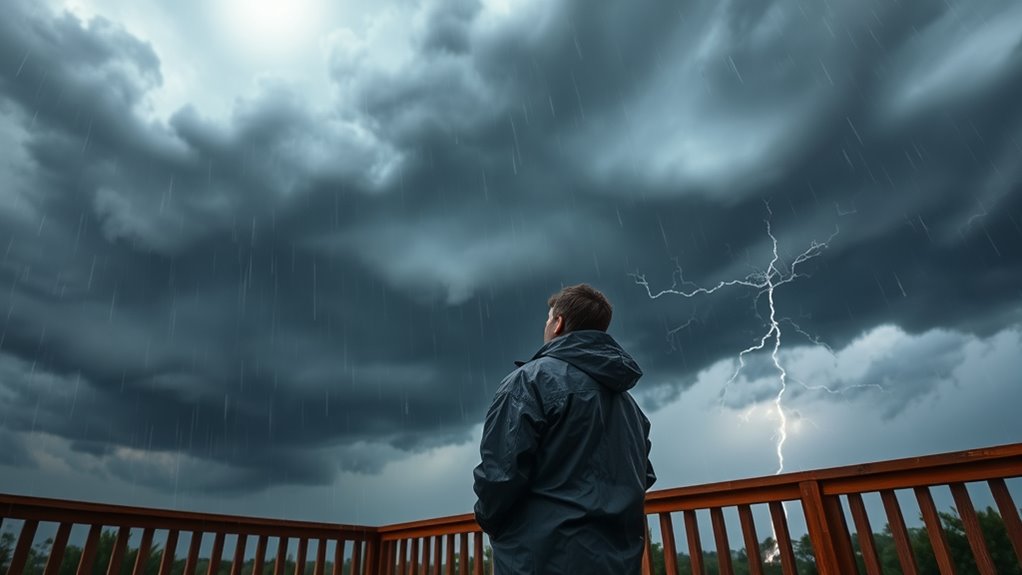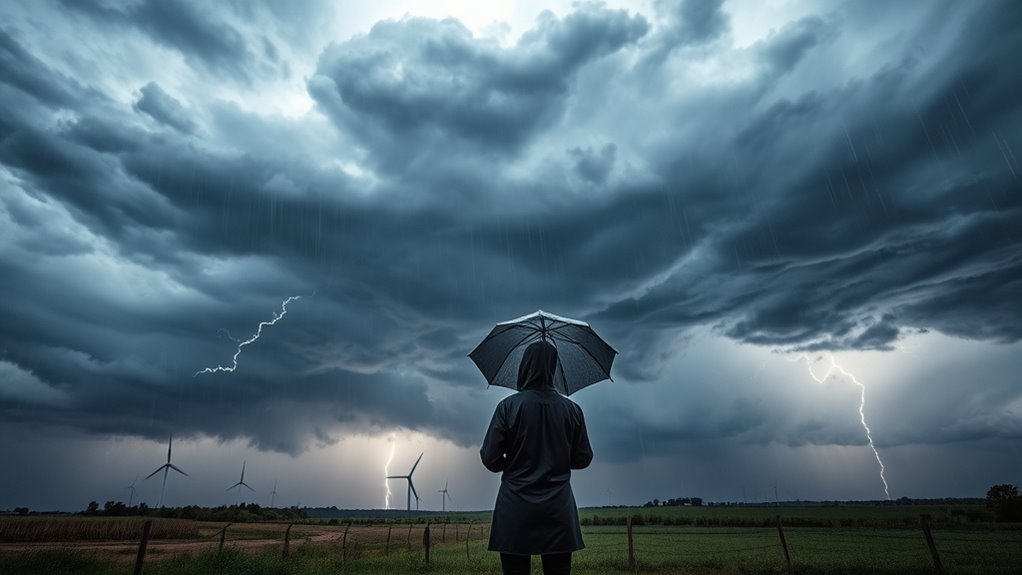Understanding weather alerts is vital for your safety. A watch means conditions are favorable for severe weather but it’s not happening yet, so stay alert and prepare. A warning indicates severe weather is imminent or occurring, so you need to seek shelter or evacuate immediately. An advisory signals less severe conditions that may cause inconvenience; stay informed and be ready to act if needed. If you want to know how each alert helps you stay safe, keep exploring the details.
Key Takeaways
- Weather watches indicate conditions are favorable for severe weather but require monitoring and preparation without immediate action.
- Weather warnings signify that severe weather is imminent or occurring, demanding immediate shelter or evacuation.
- Weather advisories warn of less severe conditions that may cause inconvenience or minor hazards, prompting caution.
- During a watch, stay alert, gather supplies, and review plans; during a warning, seek shelter or evacuate promptly.
- Understanding the differences helps ensure appropriate responses and timely actions to protect safety and property.

Understanding the different types of weather alerts is essential for staying safe during severe conditions. When a storm is approaching, knowing whether to prepare or take immediate action can make all the difference. Effective alert communication ensures you receive timely information, giving you the chance to implement your storm preparedness plan. Recognizing the distinctions between watches, warnings, and advisories helps you respond appropriately and avoid unnecessary panic or complacency.
A weather watch indicates that conditions are favorable for a specific severe weather event, such as a tornado, hurricane, or snowstorm, but it’s not yet happening. During a watch, you should stay alert, monitor local weather updates, and review your storm preparedness plans. This is the time to gather supplies, ensure your family knows the evacuation routes, and secure your property. The goal is to be ready in case the situation escalates, without causing alarm.
When a weather warning is issued, it signifies that severe weather is imminent or already occurring in your area. Warnings demand immediate action; you must seek shelter, evacuate if necessary, and stay tuned for updates. Warnings are more urgent than advisories and serve as a direct call to action. If you’re in a region prone to specific threats, like hurricanes or flooding, heeding warnings promptly can save lives and reduce damage. Having a reliable alert communication system—such as a weather radio, smartphone alerts, or community warning systems—ensures you receive these critical messages without delay.
Weather advisories are issued when conditions are less severe but still warrant caution. They inform you of ongoing or anticipated weather that could cause inconvenience or minor hazards, like heavy rain or fog. While advisories don’t usually require immediate action, they serve as helpful notices to adjust your plans accordingly. For example, you might need to delay travel or take extra precautions while driving.
Ultimately, understanding these alert types empowers you to respond effectively. During storm preparedness, it’s crucial to stay informed through multiple channels—weather apps, official broadcasts, and community alert systems. Being proactive with alert communication means you’re less likely to be caught off guard by severe weather. Recognizing the signals of watches, warnings, and advisories allows you to make quick, informed decisions, protecting yourself, your loved ones, and your property. Remember, timely and accurate information is your best tool in weather emergencies, helping you stay safe and prepared no matter what nature throws your way. Knowing how to interpret weather alerts can significantly enhance your response and safety during severe weather events.
Frequently Asked Questions
How Do Weather Alerts Impact Outdoor Event Planning?
Weather alerts greatly impact your outdoor event planning, especially during the rainy season. You need to stay attentive to watches, warnings, and advisories to guarantee outdoor safety. If a warning is issued, it’s wise to contemplate rescheduling or moving your event indoors. Being proactive helps prevent accidents or mishaps caused by unexpected weather changes. Always check alerts regularly and have contingency plans ready to keep everyone safe and comfortable.
Can Weather Alerts Predict Long-Term Climate Changes?
Weather alerts don’t predict long-term climate changes; instead, they focus on short-term events like storms or heavy rain. For climate variability and long-term forecasting, scientists analyze extensive data over decades to identify trends and shifts in climate patterns. You can stay informed about climate change through scientific reports and climate models, but daily weather alerts are designed for immediate weather conditions, not long-term climate predictions.
How Accurate Are Weather Alerts in Different Regions?
Sure, weather alerts are perfectly reliable everywhere—said no one ever. In reality, regional accuracy varies, and alert reliability depends on your location’s weather infrastructure. Coastal areas often get better forecasts than remote mountain villages. So, don’t rely solely on alerts; stay informed through multiple sources. Remember, your weather app might predict sunshine, but Mother Nature might have other plans. Always prepare, just in case.
What Technology Is Used to Issue Weather Alerts?
You rely on satellite technology and Doppler radar to issue weather alerts. Satellite technology captures images and data from space, helping meteorologists monitor weather patterns globally. Doppler radar tracks movement, intensity, and speed of storms, providing real-time information. These technologies work together to detect severe weather early, allowing authorities to issue timely watches, warnings, and advisories that keep you informed and safe during extreme conditions.
How Can Individuals Customize Weather Alert Notifications?
You can customize weather alert notifications by adjusting your notification settings on your smartphone or weather app. Explore the personalization options, where you can select specific weather alerts for your area and preferred severity levels. Enable or disable notifications for watches, warnings, and advisories, ensuring you receive timely updates tailored to your needs. This way, you’re always informed without unnecessary alerts, helping you stay safe and prepared.
Conclusion
Knowing the difference between watches, warnings, and advisories helps you stay safe during severe weather. Did you know that over 10,000 thunderstorms occur in the U.S. each year? Staying alert to the right alerts can make all the difference in protecting yourself and your loved ones. So, keep an eye on local updates, act quickly when needed, and remember—being informed is your best defense against weather hazards. Stay safe out there!










